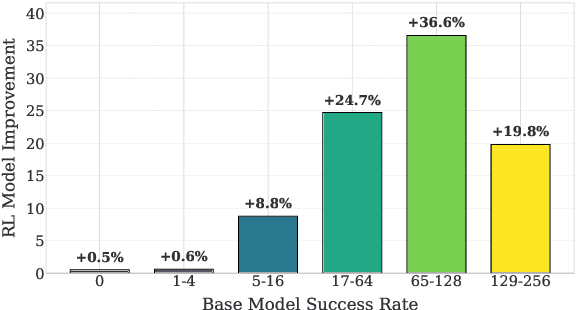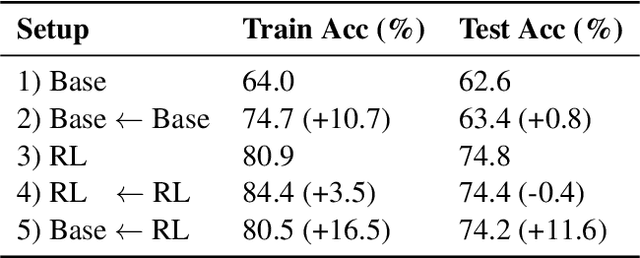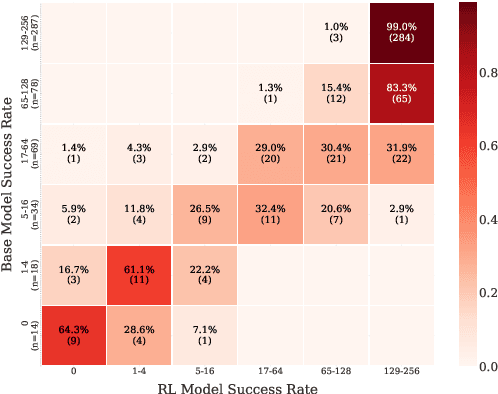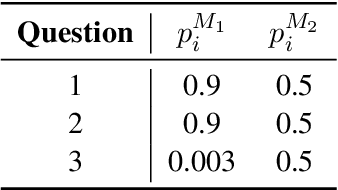Aadim Nepal
Reinforcement Learning vs. Distillation: Understanding Accuracy and Capability in LLM Reasoning
May 20, 2025



Abstract:Recent studies have shown that reinforcement learning with verifiable rewards (RLVR) enhances overall accuracy but fails to improve capability, while distillation can improve both. In this paper, we investigate the mechanisms behind these phenomena. First, we demonstrate that RLVR does not improve capability because it focuses on improving the accuracy of the less-difficult questions to the detriment of the accuracy of the most difficult questions, thereby leading to no improvement in capability. Second, we find that RLVR does not merely increase the success probability for the less difficult questions, but in our small model settings produces quality responses that were absent in its output distribution before training. In addition, we show these responses are neither noticeably longer nor feature more reflection-related keywords, underscoring the need for more reliable indicators of response quality. Third, we show that while distillation reliably improves accuracy by learning strong reasoning patterns, it only improves capability when new knowledge is introduced. Moreover, when distilling only with reasoning patterns and no new knowledge, the accuracy of the less-difficult questions improves to the detriment of the most difficult questions, similar to RLVR. Together, these findings offer a clearer understanding of how RLVR and distillation shape reasoning behavior in language models.
Warm Up Before You Train: Unlocking General Reasoning in Resource-Constrained Settings
May 19, 2025Abstract:Designing effective reasoning-capable LLMs typically requires training using Reinforcement Learning with Verifiable Rewards (RLVR) or distillation with carefully curated Long Chain of Thoughts (CoT), both of which depend heavily on extensive training data. This creates a major challenge when the amount of quality training data is scarce. We propose a sample-efficient, two-stage training strategy to develop reasoning LLMs under limited supervision. In the first stage, we "warm up" the model by distilling Long CoTs from a toy domain, namely, Knights \& Knaves (K\&K) logic puzzles to acquire general reasoning skills. In the second stage, we apply RLVR to the warmed-up model using a limited set of target-domain examples. Our experiments demonstrate that this two-phase approach offers several benefits: $(i)$ the warmup phase alone facilitates generalized reasoning, leading to performance improvements across a range of tasks, including MATH, HumanEval$^{+}$, and MMLU-Pro. $(ii)$ When both the base model and the warmed-up model are RLVR trained on the same small dataset ($\leq100$ examples), the warmed-up model consistently outperforms the base model; $(iii)$ Warming up before RLVR training allows a model to maintain cross-domain generalizability even after training on a specific domain; $(iv)$ Introducing warmup in the pipeline improves not only accuracy but also overall sample efficiency during RLVR training. The results in this paper highlight the promise of warmup for building robust reasoning LLMs in data-scarce environments.
Multimodal Deep Learning for Stroke Prediction and Detection using Retinal Imaging and Clinical Data
May 05, 2025



Abstract:Stroke is a major public health problem, affecting millions worldwide. Deep learning has recently demonstrated promise for enhancing the diagnosis and risk prediction of stroke. However, existing methods rely on costly medical imaging modalities, such as computed tomography. Recent studies suggest that retinal imaging could offer a cost-effective alternative for cerebrovascular health assessment due to the shared clinical pathways between the retina and the brain. Hence, this study explores the impact of leveraging retinal images and clinical data for stroke detection and risk prediction. We propose a multimodal deep neural network that processes Optical Coherence Tomography (OCT) and infrared reflectance retinal scans, combined with clinical data, such as demographics, vital signs, and diagnosis codes. We pretrained our model using a self-supervised learning framework using a real-world dataset consisting of $37$ k scans, and then fine-tuned and evaluated the model using a smaller labeled subset. Our empirical findings establish the predictive ability of the considered modalities in detecting lasting effects in the retina associated with acute stroke and forecasting future risk within a specific time horizon. The experimental results demonstrate the effectiveness of our proposed framework by achieving $5$\% AUROC improvement as compared to the unimodal image-only baseline, and $8$\% improvement compared to an existing state-of-the-art foundation model. In conclusion, our study highlights the potential of retinal imaging in identifying high-risk patients and improving long-term outcomes.
 Add to Chrome
Add to Chrome Add to Firefox
Add to Firefox Add to Edge
Add to Edge